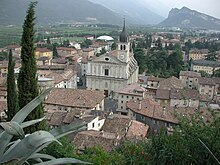Placche di Baone
The Placche di Baone ( German Platten des Baone ) are a rock face on the south side of Monte Baone ( 479 m slm ) in the mountains of Lake Garda .
Location and geology
The rock face, several hundred meters long, lies above Vigne and Chiarano, the two fractions belonging to the municipality of Arco in Trentino . The Placche di Baone consist of several plate layers that are around 30 to 70 cm thick and have an angle of inclination of up to 50 °. The plates consist of Ammonitico Rosso a sedimentary rock - formation from the Mesozoikum .
Quarry
The Placche di Baone has been used as a quarry since ancient times . In 1549 a first regulation of the use of the quarries was worked out. In contrast to the Bergregal , which was first regulated in the 12th century by the prince-bishops of Trento , the use of the quarries had not been regulated until then. The regulation stipulated that the quarries would be entrusted to the local communities, who in turn could lease the commercial use to local residents for a limited period of time and thus contributed to improving the community coffers. In addition, the locals were allowed to use the quarries for their own use. From 1613 the stones from the Baone quarry were used for the construction of the Collegiata church in Arco and later also for the construction of the Inviolata church in Riva del Garda . Until the completion of the Collegiata in 1671, which was delayed due to an outbreak of the plague in 1630 , the private use of the quarry by the municipality of Romarzollo was prohibited.
The Baone quarry was still in use in the middle of the 19th century and thus also after the new mining regulations issued by Kronland Tirol and Vorarlberg in 1832 . After the end of the First World War, the Baone quarry appears as no longer active in the static survey of the quarries carried out by the Kingdom of Italy in 1923.
The quarrying area on the Placche di Baone is around 250 m long, stone slabs 20 to 30 cm thick and blocks 70 to 80 cm thick were broken which were removed by carts of oxen. The traces of degradation can still be clearly seen at various points.
Archaeological site
On the eastern edge of Placche di Baone is under a Abri half of rock rubble buried the Riparo Monte Baone . During the stratigraphic excavations carried out by the Archeological Authority of the Autonomous Province of Trento between 1997 and 2007 , several strata were uncovered. Based on the finds, especially organic material, which indicate its use as a shelter for livestock, the bottom layer was dated to the late Neolithic and Copper Age. In addition, some fragments of the bell beaker culture were found which, as grave attachments, indicate a use as a burial site.
The discovery of a Bluzger coin from the 18th century and remains of slag bear witness to the recent use of the shelter. The archaeologists assume that counterfeit coins were made there.
It is assumed that Albrecht Dürer must have stayed near the Riparo and the Placche di Baone, since his picture of the castle of Arco, kept in the Louvre and made in 1495, shows the castle from this perspective.
Climbing area
The Placche di Baone is developed as a climbing garden and offers routes in levels of difficulty 3a to 6a in single and multi- rope routes, as well as aids for paraclimbing .
literature
- Marco Avanzini, Isabella Salvador: Uomo e pietra nel Sommolago: Storia dello sfruttamento dei materiali lapidei nel territorio di Arco tra XVI e XX secolo . In: Alexandra Chavarrìa Arnau, Marie-Ange Causarano: La memoria culturale dell'Oltresarca Trentino: Paesaggi, persone e storie di pietre . SAP Società Archeologica srl., Mantua 2018, ISBN 978-88-99547-26-4 .
- Nicola Degasperi: “Quanto desidererò il sole nel freddo”. Il riparo di Arco Monte Baone e un famoso acquarello di Albrecht Dürer. A “inconsapevole” fonte iconografica in ambito archeologico . In: Franco Nicolis, Roberta Oberosler (ed.): Ada - Archeologia delle Alpi: Studi in onore di Gianni Ciurletti . Provincia autonoma di Trento. Soprintendenza per i beni culturali, Trient 2018, ISBN 978-88-7702-457-2 .
- Franco Nicholis: Il fenomeno del "bicchiere campaniforme" tra età del Rame e età del Bronzo . In: Michele Lanzinger, Franco Marzatico, Annaluisa Pedrotti (eds.): Storia del Trentino. Volume I: La preistoria e la protostoria . il Mulino, Bologna 2000, ISBN 88-15-08369-3 .
Individual evidence
- ↑ Marco Avanzini, Isabella Salvador: Uomo e pietra nel Sommolago: Storia dello sfruttamento dei materiali lapidei nel territorio di Arco tra XVI e XX secolo p. 87.
- ↑ Marco Avanzini, Isabella Salvador: Uomo e pietra nel Sommolago: Storia dello sfruttamento dei materiali lapidei nel territorio di Arco tra XVI e XX secolo pp. 106–110.
- ↑ Marco Avanzini, Isabella Salvador: Uomo e pietra nel Sommolago: Storia dello sfruttamento dei materiali lapidei nel territorio di Arco tra XVI e XX secolo pp. 126-130, 139.
- ↑ Marco Avanzini, Isabella Salvador: Uomo e pietra nel Sommolago: Storia dello sfruttamento dei materiali lapidei nel territorio di Arco tra XVI e XX secolo p. 174.
- ↑ Franco Nicholis: Il fenomeno del «bicchiere campaniforme" tra età del Rame e età del Bronzo S. 276th
- ^ Nicola Degasperi: "Quanto desidererò il sole nel freddo". Il riparo di Arco Monte Baone e un famoso acquarello di Albrecht Dürer. Un “inconsapevole” fonte iconografica in ambito archeologico pp. 339–340.
- ^ Nicola Degasperi: "Quanto desidererò il sole nel freddo". Il riparo di Arco Monte Baone e un famoso acquarello di Albrecht Dürer. Un “inconsapevole” fonte iconografica in ambito archeologico pp. 342–343.
- ↑ Placche di Baone. In: thecrag.com. Retrieved June 11, 2020 (Italian).
- ↑ https://www.bergfex.it/sommer/trentino/touren/klettern/44719,placche-di-baone--natuerliche-kletterwand-fuers-paraclimbing-11-routen-von-4b-bis-6a/ ?
Coordinates: 45 ° 55 '25.2 " N , 10 ° 52' 17.2" E


